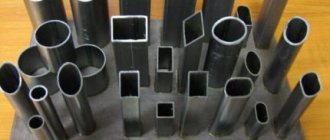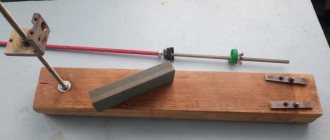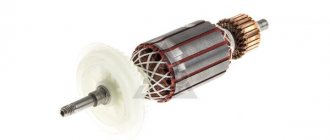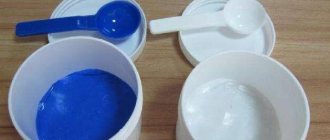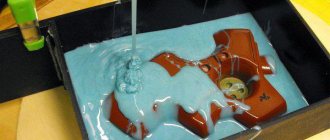To view the video, you need a modern browser that supports HTML5 video.
Despite the fact that the first pipes made from reed and bamboo were known thousands of years ago, the technology of bending metal pipes dates back only a couple of centuries. Its starting point can be considered 1824, in which the inventor of the technology for making pipes from sheet metal, James Russell, received a patent for his brainchild.
Around the same time, when the first samples of products came out of production, technologists started thinking about creating pipe benders. Today, this universal equipment can perform the most complex operations: for example, profile pipe bending services.
Technologies and equipment for pipe bending
All methods of bending pipes with a diameter from the minimum to the maximum permissible can be divided into “cold” and “hot”.
In the first case, the workpiece is not subjected to thermal influence; in the second, it is heated to a certain temperature. Whether the pipe will need heating depends on the plasticity of the material and the diameter of the pipe. Bending small-diameter pipes usually does not require pre-heating. But the customer should take into account that the offer “bending pipes to order” on the Internet may hide a completely different quality of service. Private owners and small businesses still use manual pipe benders. This option is not suitable for large-scale serial production - they use equipment of hydraulic or electromechanical modifications.
The most accurate and safe bending for rolling is guaranteed by electromechanical type machines: they can even carefully bend chrome-plated pipes without damaging the coating.
Stages of metal profile production
The main stages of the full production cycle are as follows:
- strip processing,
- production of round blanks,
- pipe profiling,
- slicing,
- quality control,
- heat treatment.
Strip processing
Raw materials for profiled pipes are supplied to the production line from metallurgical plants in the form of rolls - strips.
The rolls are unwound and cut on a slitting machine into strips of the required width. The cut segments are then welded into a continuous strip, which is wound onto a drum.
This is done to ensure continuity of production - a technological reserve of material is created to prevent downtime in the operation of the rolling machine.
Making a blank
The metal strip is transferred to the forming mill, where it is formed into a blank with a round cross-section.
When passing through the stands and rollers of a forming machine, the tape produces a continuous pipe with an open seam.
At this stage, a cold strip of steel is passed through the forming mill or heat treatment is carried out immediately.
We recommend that you read: How to solder heating pipes correctly?
The pipe is transferred to a welding machine, where the seam is closed to form a blank. Welding is carried out using a furnace method, in shielding gas or with high-frequency currents. The seam can be straight or spiral.
During welding, the machine rollers compress the edges of the seam to increase the strength of the joint, resulting in the formation of flash - excess molten metal pressed into the pipe and onto its outer surface. The burr is removed with a cutter, after which the workpiece is cooled with an emulsion composition.
Important! The process of cooling the workpiece with the emulsion composition continues both at the profiling stage and during cutting.
Pipe profiling
Depending on the cross-sectional shape that needs to be obtained, pipe profiling takes place in one or two stages.
- The workpiece is passed through sizing rollers, which level the workpiece. After calibration, it has the same cross-section along its entire length. If a pipe of oval or flat-oval cross-section is required, then its profiling ends there.
- If a triangular, square, rectangular or polygonal cross-section is required, the workpiece is passed through a profiling machine. The rollers of this machine compress a round pipe to the desired shape.
Slicing
The finished continuous pipe is cut to specified dimensions without stopping the cooling process.
For additional protection of finished profile pipes, cold or hot galvanizing is used:
- The first method is to apply a layer of powder or polymer paint to the metal profile.
- The second method differs in that the finished pipe is pre-cleaned, dipped into a bath of molten zinc, and then cooled and dried.
Quality control
Strict requirements are imposed on profile pipes manufactured under full cycle conditions. An obligatory stage in the production of metal profiles is quality control.
The tightness of the seam is especially carefully controlled, since the weak point of welded pipes is the seam.
Two verification methods are used:
- visual inspection,
- eddy current flaw detection.
The specialist inspects the seam and identifies seam irregularities caused by welding defects and damage caused by improper operation of the rollers.
We recommend that you read: Production and use of PVC pipes
The second verification method is hardware. The operation of the flaw detector is based on comparing the electromagnetic characteristics of the metal in all areas of the seam.
These characteristics are affected by the chemical composition of the material and the presence of physical defects. The flaw detector helps to identify areas of lack of welding in the seam and shell that were not noticed during a visual inspection.
The production process is considered completed, and the product is allowed for sale only after quality control has been carried out.
Round pipe bending
The bulk of orders entering our metalworking shop are related to flexible round pipes.
This is a more universal product, and it is the one that is used by the leading consumer areas of rolled pipes - network installation, construction and housing and communal services. In modern realities, people are increasingly talking about bending pipes along a radius, although the term “radius deformation” was originally used for metal sheets. It is understood as an operation that helps to achieve a rounded shape of the workpiece without changing its internal structure. In the case of bending round pipes, this task becomes much more complicated, since it is necessary to maintain the shape and dimensions of the section at the bending point.
To avoid thinning of the walls and rupture, the operation is carried out taking into account all the characteristics of the workpiece:
- material;
- section diameter;
- wall thickness;
- angle to which the pipe needs to be bent.
For complex products, technologists specially calculate the maximum permissible deformation values. To maintain the shape of the workpiece, especially when bending a pipe on rollers, it is filled with filler, which is usually sand.
Hot bending - how is it done?
Hot deformation makes it possible to bend the toughest pipes. Moreover, as in the case of cold bending, the hot version can be implemented using only two technological processes: manual and mechanical deformation.
Hot manual bending
Hot hand bending is performed using the same methods as cold hand bending. That is, we
We practice the same methods: winding on a gauge and deformation on supports. Only before feeding the product onto the gauge or onto the supports is it heated.
Moreover, the equipment needed for bending pipes manually using a hot method is almost exactly the same as for cold deformation. Only in the process of “hot” processing is a blowtorch or cutter also used, which warms up the deformation site.
Therefore, water is not used as a filler in the hot bending process.
Mechanical hot bending
This method is practiced when processing products on roller pipe benders. Moreover, the tools used during bending are absolutely identical to those used in the cold deformation process. There is only one difference between the hot and cold processes - in the case of hot bending, the pipe is heated before being fed into the pipe bender. This move allows you to get the result without much hassle: after all, in this case, less deforming force needs to be applied to the deforming rollers.
Bending of profile pipe using CNC equipment
Particular trouble is caused by bending profile pipes along a radius.
During the deformation process, these billets experience the same stresses as round steel: during the process, the outer wall of the pipe becomes thinner under the influence of tension, and the inner wall, which is affected by compression, on the contrary, thickens. The difficulty is that for profile pipes, compared to round ones, this effect of compression and stress increases significantly. That is why services for bending profile pipes, and even rolled products with a round cross-section, are increasingly provided on CNC equipment. Electronic machines not only perform ultra-precise bending down to tenths of a degree, but also analyze information on the elasticity of the metal, warning of possible risks.
How to bend a pipe without preheating
You can bend a profile pipe yourself without preheating it, either with or without filler. Pipes whose profile height does not exceed 10 mm do not require filling with sand or rosin.
The nuances of bending small-sized thin-walled pipes
There is another technique that involves using a spring with tightly wound coils instead of a filler, which is inserted into the internal cavity of the corrugated pipe and protects the walls of the product from deformation, as well as from excessive changes in their thickness during the bending process.
Drawing and details of a mechanical pipe bender for profile pipes
The design of a basic pipe bending device is simple and accessible for self-production
For those who need to bend profile pipes with their own hands without heating them first, you can use the training video and the following simple recommendations.
- You can obtain the required bend on profile pipes using the simplest devices - a vice, mandrels, bending plates.
- You can use a manual pipe bender for products with a round profile. In this device, it is necessary to remake the working rollers, the shape of the recess in which must correspond to the profile of the pipe.
- The most efficient and accurate way to bend pipes is with a roll forming machine, which you can purchase or make yourself.
Areas of use of bent pipes
Despite the lion's share of demand in the construction of networks and highways, pipes are used not only in them. They can be applied:
- as a structural element in the construction of buildings and structures;
- as an element of fencing;
- as roofing elements - for example, awnings and cornices;
- in the construction of greenhouses, greenhouses, greenhouses;
- in the assembly of equipment;
- as an element of decor and design.
We are capable of not only the most complex bending operations, but also the production of parts from pipes, and, if necessary, their assembly into a structure.
Production technologies
Rolled metal manufacturers produce profile pipes in two ways: by rolling a round pipe, when it is converted from regular to profiled, and full-cycle production, which is the production of a profile pipe from sheet material.
Round pipe profile
To make a metal profile from a round pipe, just one rolling machine is enough. The necessary equipment is affordable and compact and is used by both pipe rolling companies and individuals . The technology, called cold deformation, does not require much time and energy.
We recommend that you familiarize yourself with: Types of corner valves and rules for their operation in heating systems
Production consists of only two stages: procurement of the workpiece and its completion. A welded or seamless pipe is given the desired shape by passing it between the rollers of the machine.
The profiled pipe obtained in this way has sufficient strength for the manufacture of furniture and decorative elements, construction of a gazebo or greenhouse. Such pipes are not suitable for the construction of serious objects requiring high strength.
Full production cycle
For the construction of structures that have high demands on their strength, only profile pipes obtained under full cycle conditions are used.
Such rolled metal is more expensive, but much more reliable than profiled round pipe.
To manufacture a profile pipe, strip is used - sheet material made of low-alloy or carbon steel. A round blank is made from the strip, which is then profiled.
The full cycle line includes several machines, the main ones:
- profile bending,
- welding,
- rolling,
- cutting line.
During the full production cycle, pipes undergo quality control. Additionally, galvanization and heat treatment are carried out.


